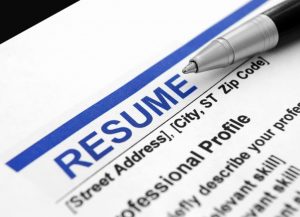How to Format Your Resume for a Job Search
 Over the course of my recruiting career, I have seen more resumes than I could ever count. Naturally, they have run the gamut of perfectly formatted to completely unreadable. I always stress the importance of resume formatting to all of the candidates I work with, because it is a significant factor in whether or not they are considered for the position they applied for.
Over the course of my recruiting career, I have seen more resumes than I could ever count. Naturally, they have run the gamut of perfectly formatted to completely unreadable. I always stress the importance of resume formatting to all of the candidates I work with, because it is a significant factor in whether or not they are considered for the position they applied for.
The rule of thumb is this: if the employer or headhunter struggles to decipher your resume because of poor grammar or formatting, they will most likely throw it out immediately. Since your resume is really the first impression you give, it is vital that you make it as easy as possible for others to read it and comprehend it, or else you probably won’t get a chance to make an impression in person.
Because some of these issues are never noticed by the candidate until it is too late, I wanted to give you a checklist to follow for properly formatting your resume. If all these items are in order, your resume has a much better chance of making it onto the shortlist.
Rules for Resume Formatting
- Your resume needs to be compatible with the employer’s computer programs! Microsoft Word and PDF readers are used almost universally, so my recommendation is to send your resume as a .doc, .docx, or .pdf file. This is an especially important consideration for Mac owners who use a program like Pages for their documents. You must remember that the employer or recruiter is much less likely to be using Pages, so take all necessary steps to convert your document before sending it to them. If you want to be extremely well-prepared, you can always send your resume in a couple of different formats to give the employer some options; however, make sure that you don’t send too many at one time, or you run the risk of creating issues with their email client.
- Always attach your resume to your email! Please do not ask the headhunter or employer to go find your resume online, like your LinkedIn profile or other job boards. The primary reason goes back to my initial rule of thumb: if it takes much effort to find or read your resume, they probably won’t bother. Another reason is that they may not have access to the job board you referred to, or they may not be able to find your profile easily, and thus decide to give up and move on to the next candidate. A final reason is that your online profile is likely not the most complete or well-formatted version of your resume, which doesn’t give them the best representation of you.
- Always send an original digital version of your resume! It is very unwise to scan a hard copy and email the scanned image. You might not realize it, but the image could come out blurry, scratched, or even totally unreadable. Take the time to locate the original digital version of your resume, or if you can’t find it, type out a new one. Trust me, it is worth the extra few minutes of your day!
- Assign a proper title to your resume! The title of “My Resume” is not helpful to the recruiter or employer, because once saved in their document folder, it will become completely anonymous at first glance. The last thing you want to become is the anonymous candidate, so double check this before attaching it to the email. The best title will include your name and the date which you send it, so they have a reference point for its relevance.
- Make your resume easy to scan through quickly. Long paragraphs, lack of physical line separation, and unlabeled sections make it very difficult to read. Here are my suggestions for improvement:
- Use boldface and italics to highlight important phrases, like previous and current employers, job titles, dates at each company, etc., so that the employer can easily pick out where you’ve worked and what your positions were.
- Separate and label your work history, education, and reference sections clearly.
- Make sure your work history is listed chronologically from most recent to oldest and not vice versa so you don’t confuse the employer on timelines.
- Make sure all your contact information is up to date and listed at the top.
- Try to use bullet points for lists like job duties or accomplishments, as these are more visually attractive and comprehensible.
- Proofread for any grammar or spelling errors, as these will damage your professional image.
For more resume writing and formatting assistance, take a look at our information and links here. We are here to help you present yourself at your very best, so please don’t hesitate to ask us if you have any further questions.